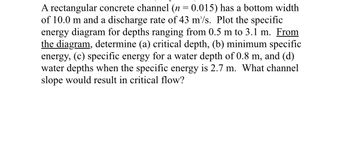
Structural Analysis
6th Edition
ISBN: 9781337630931
Author: KASSIMALI, Aslam.
Publisher: Cengage,
expand_more
expand_more
format_list_bulleted
Concept explainers
Question

Transcribed Image Text:A rectangular concrete channel (n = 0.015) has a bottom width
of 10.0 m and a discharge rate of 43 m³/s. Plot the specific
energy diagram for depths ranging from 0.5 m to 3.1 m. From
the diagram, determine (a) critical depth, (b) minimum specific
energy, (c) specific energy for a water depth of 0.8 m, and (d)
water depths when the specific energy is 2.7 m. What channel
slope would result in critical flow?
Expert Solution
This question has been solved!
Explore an expertly crafted, step-by-step solution for a thorough understanding of key concepts.
This is a popular solution
Trending nowThis is a popular solution!
Step by stepSolved in 4 steps with 7 images

Knowledge Booster
Learn more about
Need a deep-dive on the concept behind this application? Look no further. Learn more about this topic, civil-engineering and related others by exploring similar questions and additional content below.Similar questions
- I need the answer as soon as possiblearrow_forwardWater flows in a horizontal, rectangular channel initially 10 feet wide and 2 feet deep. The initial velocity is 6 ft/s. This flow encounters downstream a simultaneous downward step and constriction. No energy losses are associated with these changes in channel configuration. a. What is the specific discharge, q: i. Upstream (for w= 10 feet)? ii. Downstream (for w = 6 feet)? b. What specific energy, E, is associated with the flow as initially specified (at the upstream location)? c. What is the minimum energy needed to pass the full discharge at the downstream location? d. What is the height (Az) of the smallest downward step necessary for the upstream flow conditions to remain as specified?arrow_forwardQuestion One Determine the flow rate in a confined aquifer with a hydraulic conductivity of 20m/d, and thickness of 6.6m. The initial piezometric surface is 14.53 above the lower confining bed, causing the piezometric surface to be 13.85m at a radius of 40m and a 14.31m at a radius of 85m. The solution should include a labeled diagram.arrow_forward
- For a constant specific energy of 6.60 ft in a rectangular channel 10 ft wide, determine (a) the critical depth (ft), (b) the critical velocity (ft/s), (c) the channel bed slope to maintain critical depth, and (d) the maximum flow (cfs) that may occur. Use n = 0.011.arrow_forwardDetermine the kinetic energy correction coefficient for the compound channel shown in Figure 2.1 below. Im V,=0.5m/s V,=0.3m/s 20m 22m 3m Figure 2.1 4m V,=1.5m/sarrow_forward
arrow_back_ios
arrow_forward_ios
Recommended textbooks for you

 Structural Analysis (10th Edition)Civil EngineeringISBN:9780134610672Author:Russell C. HibbelerPublisher:PEARSON
Structural Analysis (10th Edition)Civil EngineeringISBN:9780134610672Author:Russell C. HibbelerPublisher:PEARSON Principles of Foundation Engineering (MindTap Cou...Civil EngineeringISBN:9781337705028Author:Braja M. Das, Nagaratnam SivakuganPublisher:Cengage Learning
Principles of Foundation Engineering (MindTap Cou...Civil EngineeringISBN:9781337705028Author:Braja M. Das, Nagaratnam SivakuganPublisher:Cengage Learning Fundamentals of Structural AnalysisCivil EngineeringISBN:9780073398006Author:Kenneth M. Leet Emeritus, Chia-Ming Uang, Joel LanningPublisher:McGraw-Hill Education
Fundamentals of Structural AnalysisCivil EngineeringISBN:9780073398006Author:Kenneth M. Leet Emeritus, Chia-Ming Uang, Joel LanningPublisher:McGraw-Hill Education
 Traffic and Highway EngineeringCivil EngineeringISBN:9781305156241Author:Garber, Nicholas J.Publisher:Cengage Learning
Traffic and Highway EngineeringCivil EngineeringISBN:9781305156241Author:Garber, Nicholas J.Publisher:Cengage Learning


Structural Analysis (10th Edition)
Civil Engineering
ISBN:9780134610672
Author:Russell C. Hibbeler
Publisher:PEARSON

Principles of Foundation Engineering (MindTap Cou...
Civil Engineering
ISBN:9781337705028
Author:Braja M. Das, Nagaratnam Sivakugan
Publisher:Cengage Learning

Fundamentals of Structural Analysis
Civil Engineering
ISBN:9780073398006
Author:Kenneth M. Leet Emeritus, Chia-Ming Uang, Joel Lanning
Publisher:McGraw-Hill Education


Traffic and Highway Engineering
Civil Engineering
ISBN:9781305156241
Author:Garber, Nicholas J.
Publisher:Cengage Learning